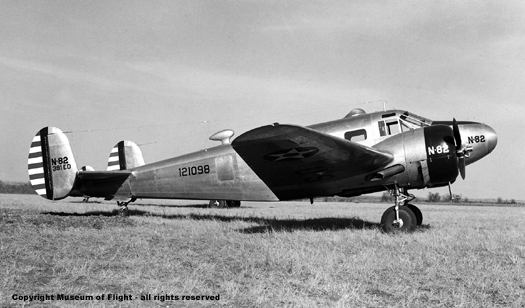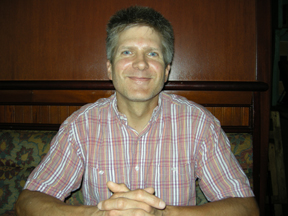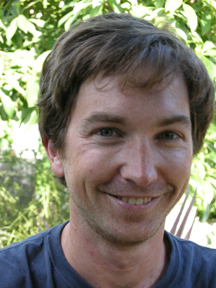|
 |
|
Beech 18 AT-7
Navigator Copyright
Museum of
Flight - all rights reserved
August, 2008 |
|
FINAL FLIGHT
a blog by Peter Stekel
FINAL FLIGHT is the story of four
aviators lost in Sequoia & Kings Canyon National Parks on November 18,
1942 |
|
FINAL FLIGHT, coming from
Wilderness Press in 2010 |
|
Read more about FINAL FLIGHT
here. |
| |
| |
|

Coming August 31, 2008 from
The
Fresno Bee
CENTRAL
CALIFORNIA’S LEADING NEWSPAPER
“Lost
Flights: The Sierra’s deadly legacy,” a
series of print stories and online reports by The Bee’s Mark Grossi and Cyndee
Fontana.
Come with us Aug.
31-Sept. 17 and relive the stories of doomed flights. Examine the Sierra’s
dangerous terrain and weather. Learn why there are so many crashes and why
it's so difficult to recover lost planes.
In the center of the
series, Grossi and photographer Mark Crosse will bring the Sierra front
and center when they hike to Mendel Glacier in search of the remains of
airmen who were lost on a training flight in 1942. Join them as they blog
live from the mountain.
The series will
package stories, photos, maps, charts, videos, audio clips and blogs for an
in-depth review of Sierra plane crashes.
You can join the journey now; enjoy early
blogs, galleries and more at
www.fresnobee.com/lostflights
Be sure to bookmark
the page so that you can keep up with the series as it unfolds in print
and online Aug. 31 through Sept. 17, only in the Fresno Bee. |
| |
| August 18 |
| Mark Grossi, a reporter and
columnist for the Fresno Bee, has begun a blog - Glacial Mystery -
searching the ice for long-dead bodies,
HERE. He and a
photographer will be hiking to Mendel Glacier in September as part of a
long feature story Mark is preparing for the Bee. We're planning on
meeting each other in Darwin Canyon for an interview.
Mark has been following the Final Flight story very
closely, dating back to 2005 when Leo Mustonen was found. His articles are
well-written and accurate. Check out his blog! He is hoping to be able to
make additions during his September backpacking trip by using a satellite
phone. To paraphrase Eugene O'Neill [who borrowed the quote from the
Rubaiyatt of Omar Khayyam] "Ah; Technology!" |
| |
| August 11 |
| Today I had the distinct
pleasure of talking with Steve Johnson, a meteorologist in Fresno who knows
Sierra Nevada weather from the ground and from the air. Steve runs a
cloud-seeding company and has spent a lot of time studying Sierra weather.
Steve has not only hiked in the Sierra but he has flown over it quite a
bit in good weather as well as bad. And, like me, he has developed quite
an interest in what happened November 18, 1942 when Lt. William Gamber
flew his airplane over Kings Canyon National Park. It
has always been my assumption, based on the 1942 and 1947 US Army accident
reports that bad weather caused the pilot to get lost. This has always
been the assumption of everyone else over the last 66 years. True, I have evidence
that at least one other training mission was forced to turn back to base
on November 18 because they encountered bad weather.
But blaming bad weather is too easy. And too dismissive
of Bill Gamber's training and experience. Too convenient also because, as
an explanation, it ignores so many things.
- If one plane [and presumably other missions that day]
turned back [as no one else was lost], why didn't Gamber?
- Why was Gamber flying so high? Probably because he
knew there were mountains in front of him.
- Why was he heading west when he crashed? Probably
because the weather was clear in the Owens Valley?
- What was he doing in the Owens Valley in the first
place - after all, the flight plan in the 1942 accident report says he
was to fly south down the Central Valley and then north. It says nothing
about flying east. In one of his last letters to his mother, Glenn Munn
wrote about a training mission coming up in early November to Phoenix
and having just returned from Salt Lake City and hoping the next time
they flew there [also in a couple of weeks] they would be able to land
this time and look around.
- The accident report was completed and filed in
December, 1942. The page with the aircraft's flight plan was included in
the report a week after Gamber and his cadets disappeared.
There is more. And having a better understanding of what
the storm was doing, and at what time and at what place it was doing it
at, will be an immensely important addition to Final Flight.
Steve is working on reconstructing the weather, not only
for November 18 but for several days before when a tropical storm was
hammering the west coast. As can be imagined, I'm really looking forward
to what he comes up with. I plan to meet with
Steve Johnson in early October when I return from my trip to Kings Canyon
National Park and Mendel Glacier. |
| |
| August 6 |
|
I met with Michael Nozel and Hassan
Basagic this afternoon. Michael is one of the two climbers who found
Leo Mustonen in 2005 and Hassan is a geologist studying Sierra Nevada
glaciers and why they are melting. It was a great pleasure to meet
both of them.
Both were very interested in seeing the
photographs of Mendel Glacier from 1947 and 1948 that I've obtained
from Kirby West and the family of Capt. Roy Sulzbacher. Michael was
jazzed by the amount of snow and ice in Ice 9 and the couloir beside
it, Mendel Right. Hassan was excited to see photos of the glacier
taken from ground level since these are hard to find.
Michael and his climbing partner, Mark
Postle, intended to climb the Ice 9 [aka Mendel Left] Couloir in
October, 2005. After making the long drive from Oregon and hiking over
Lamarck Col in the dark, they got to upper Darwin Canyon. It was cold
and windy and conditions didn't change the next day. |
Nevertheless, the following morning they got an early
start and made their way into Mendel Cirque and began working their
way across the glacier. Michael saw something fluttering in the wind -
it turned out to be a parachute. Attached to the parachute was the
body of Leo Mustonen. Putting
their climbing plans on hold, the two friends hiked all the way out to
Bishop - a snow storm at their heels. |
|
 |
|
In Bishop they reported their find to
the Bishop Police Department and Deputy Paul Baldwin with the Inyo
County Sheriff's Department.
Neither of the climbers were interested
in talking to the media - they felt very strongly that neither of them
had anything to do with the story. As Michael told me, "We had been
there for recreational purpose and now we find, possibly, the remains
of someone who had been entombed in Mendel Glacier for a long time. A
lot of things start to come to your mind. Certainly, thinking that if
this is the first time this discovery had been made and this person
had been there for a long, long time... What ramifications is this
going to have for the family members? What ramifications for the
military to finally know for sure that this is where the person came
to finally rest."
He had a humorous story to tell about
someone from the TV show, "Good Morning America" being insulted and
getting all hot under the collar because Michael and Mark had no
interest in going on the show to talk about their trip to the glacier.
"They just couldn’t believe we weren’t
interested!" he told me, while laughing at the memory. "That this
individual had the audacity to get surly and tell us that this was
bigger than the two of us. And that we had some kind of obligation
- that we had to go with the news. This was the news! And the news is
bigger and you can’t ignore the news!" He kept laughing as he told me
this. "It’s a train that you can’t stop! And, indeed, it is
bigger than us and that is why we’re not interested in being on the
news." |
|
|
Hassan Basagic has recently completed
his masters degree at Portland State University. For his research
about the incredibly shrinking glaciers of the Sierra Nevada he hiked
all over Sequoia & Kings Canyon National Parks and Yosemite National
Park. Part of his work involved taking photographs and comparing them
to historic images - some of which are 100 years old. Hassan's work
documents that Sierra glaciers are indeed shrinking. |
 |
During our interview I learned that Mendel Glacier is a bit of an odd
duck. Neither a "clean" glacier [of ice, ice and more ice] nor a true
rock glacier [where ice and rock are all mixed up together] the Mendel
is something in between. It likely has an ice core [like a clean
glacier] but is covered to some depth by rocks, boulders and debris.
Adding to its oddness is that the Mendel's bergschrund
is not at the head of the cirque but is off to one side [the cirque
faces east, the bergschrund faces north] which makes the glacier move
downslope north and then turn right [east].
Some other things Hassan helped me to
realize about the Mendel Glacier: |
|
-
The glaciers we see in the Sierra
Nevada reached their maximum between about 1850 and 1900 during a
period known as "Little Ice Age."
-
The Little Ice Age [LIA] commonly (and
roughly) refers to the cool period that lasted 800 - 1000 years ago
(about 1200 - 1900). The Mendel cirque likely had ice prior to the LIA,
which Douglas Hansen and his students at the University of Western
Washington have shown in their studies making us of lake
sediments. So, the glaciers are considered to be late-Holocene
[beginning around 8000 BC.
-
The Mendel Glacier is probably deepest
just below the bergschrund and could be between 50-80 meters deep.
-
Downslope movement is less in a rock glacier than in a clean glacier -
perhaps a meter/year.
-
Any plane wreckage that fell,
scattered, on the glacier's surface probably became incorporated into
the glacier, especially given that the mid-1940s experienced heavy
winters. Large pieces, once exposed by the glacier shrinking in size,
will lead to that section of glacier preferentially melting - just as
a rock placed on the surface would do. This could explain why the
aircraft's engines were seen poking out of the ice in 1947 while
nothing else was seen.
-
In a way, a rock glacier is like one
endless moraine with an ice core.
-
Rock glaciers melt slower than clean glaciers because they are
insulated by the rock inside them and the debris on top of them. This
allows more debris to accumulate over time. The Mendel probably has an
ice core and began as a clean glacier. It has turned into a rock [or
debris-covered] glacier over time as it has been melting - with rock
debris being added to the top and then being covered with snow which
turned to ice.
-
Rock glaciers are more prevalent along
the Sierra crest and they flow east.
-
Since the 1920s and 1930s Sierran
glaciers have been shrinking though that process slowed down in the
1980s and 1990s. In fact, in the 1930s, a Bighorn Sheep ram melted out
of the Lyle Glacier in Yosemite National Park. Now, with increased
temperature and decreased snowfall, it is likely that more objects
will appear - melting out of Sierran glaciers.
-
Sierra glaciers will probably never
completely disappear unless climate change becomes very severe. As the
glaciers shrink, they recede up into more protected areas of the
cirque. Here they can be maintained by winter snowfall, snow blowing
off the peaks and avalanches during the winter.
|
| |
2009
December November October
September August July June
May April March February January
2008
December November October September August
July
June
May
April March February
January
2007
December November
October
September |
| |
| |
|
|
write to:
peter[at]FinalFlightTheBook.com |
|
|
|
FINAL FLIGHT, coming from
Wilderness Press in 2010 |



